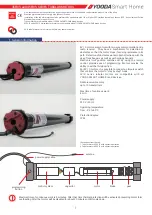
OPM 200 en-GB
26
©
Scania CV AB 2014, Sweden
Starting and running
Coolant temperature
Normal coolant temperature during operation is
80-90°C/176-194°F.
Alarm levels are set in the engine control unit.
The default setting for the lowest and highest
limit values for high coolant temperature are
95°C/203°F and 105°C/221°F respectively.
The following function is standard as alarm for
high coolant temperature:
•
Alarm and torque reduction at the lowest lim-
it value.
Depending on the engine configuration, the fol-
lowing alarm functions may also be available:
•
Alarm only.
•
Alarm and engine shutdown at the highest
limit value.
•
Alarm, torque reduction at the lowest limit
value and engine shutdown at the highest lim-
it value.
•
Alarm and engine shutdown at the highest
limit value with the possibility of engine shut-
down override control.
•
Alarm, torque reduction at the lowest limit
value and engine shutdown at the highest lim-
it value, with the possibility of engine shut-
down override control.
If run for extended periods under an extremely
light load, the engine may have difficulty in
maintaining the coolant temperature. At an in-
creased load the coolant temperature rises to the
normal value.
IMPORTANT!
An excessively high coolant temperature can
damage the engine.
Oil pressure
Information about the normal oil pressure and
lowest permitted oil pressure is contained in the
section headed Technical Data.
The engine management system has the follow-
ing alarm levels:
•
At an engine speed below 1,000 rpm and an
oil pressure below 0.7 bar/10.2 psi.
•
At an engine speed above 1,000 rpm and an
oil pressure below 2.5 bar/36.3 psi for longer
than 3 seconds.
The following function is standard as alarm for
incorrect oil pressure:
•
Alarm and torque reduction by 30%.
Depending on the engine configuration, the fol-
lowing alarm functions may also be available:
•
Alarm only.
•
Alarm and engine shutdown.
•
Alarm and engine shutdown override control.
Note:
High oil pressure (above 6 bar/87 psi) is normal
when starting a cold engine.
Charging indicator lamp
If the lamp comes on during operation:
•
Check and adjust the alternator drive belts as
described under the corresponding inspection
point. See the Inspection section.
If the charging indicator lamp is still on, this
could be due to an alternator fault or a fault in the
electrical system.
Belt transmission
When the belt transmission is new, it may make
a squeaking noise when running. The noise is
normal and disappears after 50-100 hours of op-
eration.
The noise does not affect the service life of the
belt transmission.
Property of American Airlines
















































